Business Law: Case Study on Advocacy and Disability Rights, HDS310
VerifiedAdded on 2022/10/12
|6
|1590
|19
Report
AI Summary
This report presents an analysis of a business law case study centered on an Australian airline's refusal to allow a person with a disability to book a flight, citing insufficient staff assistance. The assignment brief required the student to develop an advocacy campaign incorporating the essential elements and strategies of advocacy learned in the course. The report recommends systems advocacy as the appropriate redressal approach, emphasizing its role in removing discriminatory practices and upholding the rights of disadvantaged individuals. It outlines the strategies of a systems advocate, including influencing politicians, submitting policy recommendations, and increasing group visibility. The report details the application of the advocacy approach to the case study, proposing an advocacy plan, revised policies, and amendments to relevant legislation to ensure equal treatment for disabled individuals. The report concludes by highlighting the importance of advocacy in restoring peace and conformity between disadvantaged people and those affecting them, particularly through systems advocacy, which aims to influence government and institutions to reform regulatory policies and bring about societal change. References are provided to support the analysis.
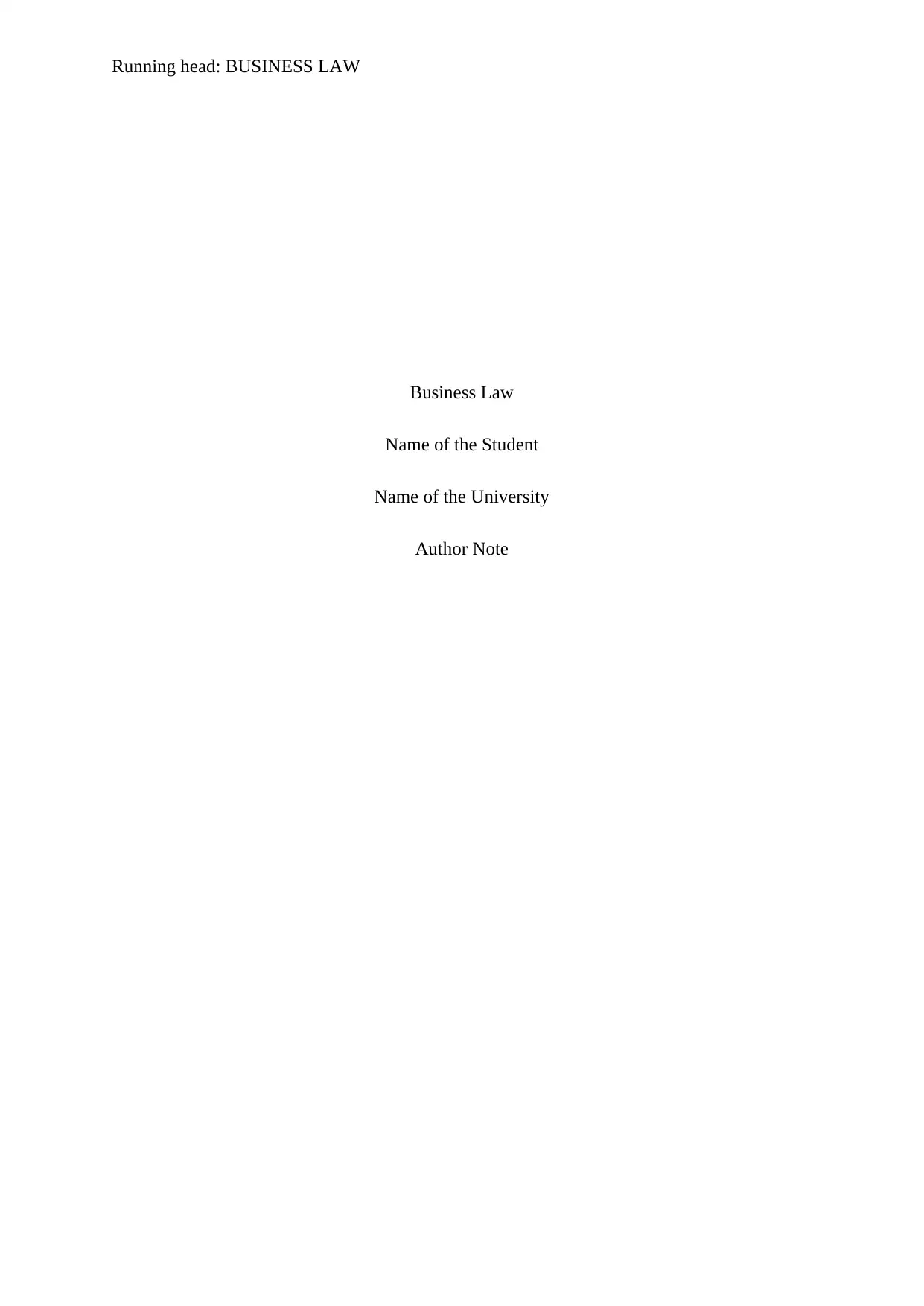
Running head: BUSINESS LAW
Business Law
Name of the Student
Name of the University
Author Note
Business Law
Name of the Student
Name of the University
Author Note
Paraphrase This Document
Need a fresh take? Get an instant paraphrase of this document with our AI Paraphraser
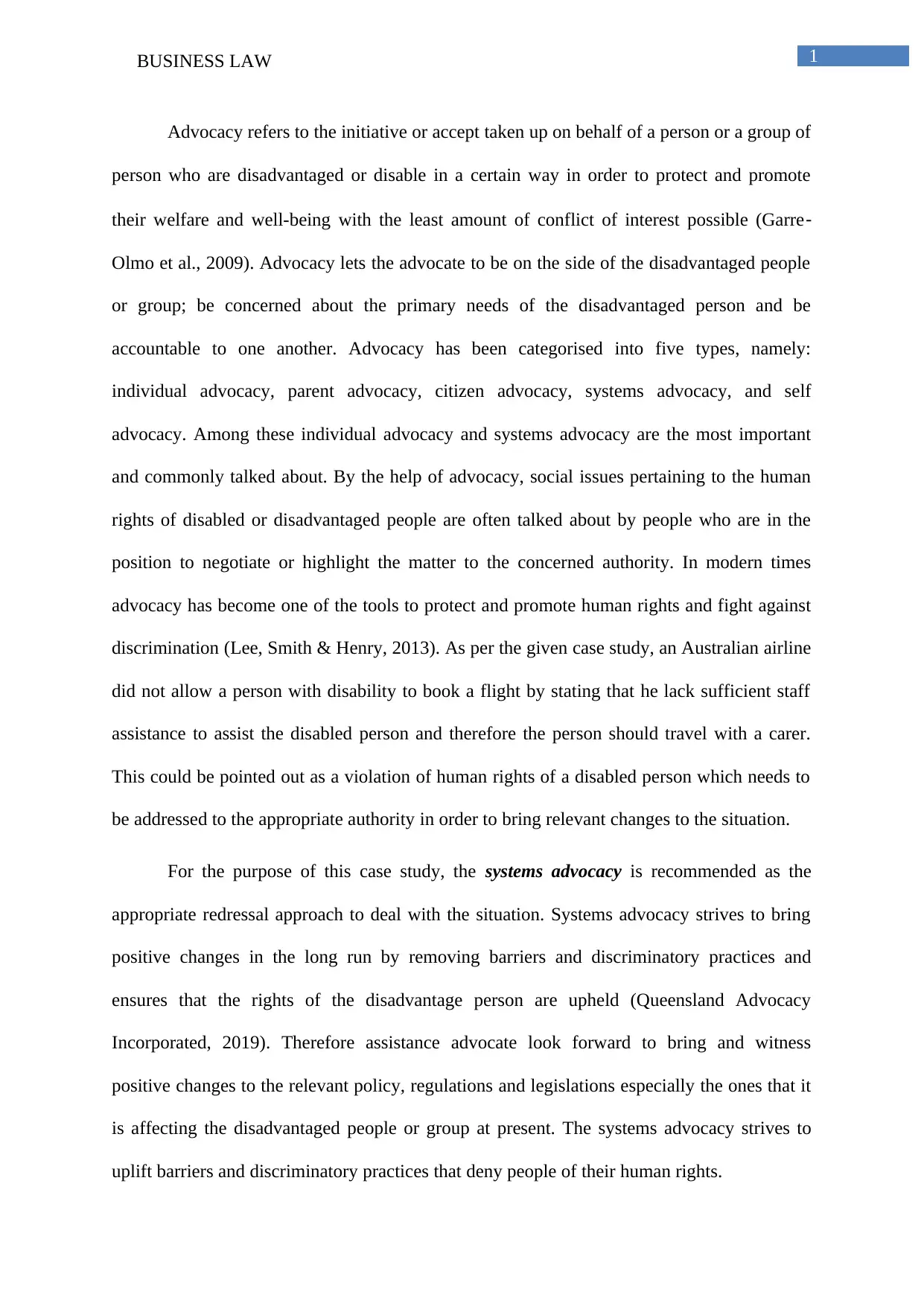
1BUSINESS LAW
Advocacy refers to the initiative or accept taken up on behalf of a person or a group of
person who are disadvantaged or disable in a certain way in order to protect and promote
their welfare and well-being with the least amount of conflict of interest possible (Garre‐
Olmo et al., 2009). Advocacy lets the advocate to be on the side of the disadvantaged people
or group; be concerned about the primary needs of the disadvantaged person and be
accountable to one another. Advocacy has been categorised into five types, namely:
individual advocacy, parent advocacy, citizen advocacy, systems advocacy, and self
advocacy. Among these individual advocacy and systems advocacy are the most important
and commonly talked about. By the help of advocacy, social issues pertaining to the human
rights of disabled or disadvantaged people are often talked about by people who are in the
position to negotiate or highlight the matter to the concerned authority. In modern times
advocacy has become one of the tools to protect and promote human rights and fight against
discrimination (Lee, Smith & Henry, 2013). As per the given case study, an Australian airline
did not allow a person with disability to book a flight by stating that he lack sufficient staff
assistance to assist the disabled person and therefore the person should travel with a carer.
This could be pointed out as a violation of human rights of a disabled person which needs to
be addressed to the appropriate authority in order to bring relevant changes to the situation.
For the purpose of this case study, the systems advocacy is recommended as the
appropriate redressal approach to deal with the situation. Systems advocacy strives to bring
positive changes in the long run by removing barriers and discriminatory practices and
ensures that the rights of the disadvantage person are upheld (Queensland Advocacy
Incorporated, 2019). Therefore assistance advocate look forward to bring and witness
positive changes to the relevant policy, regulations and legislations especially the ones that it
is affecting the disadvantaged people or group at present. The systems advocacy strives to
uplift barriers and discriminatory practices that deny people of their human rights.
Advocacy refers to the initiative or accept taken up on behalf of a person or a group of
person who are disadvantaged or disable in a certain way in order to protect and promote
their welfare and well-being with the least amount of conflict of interest possible (Garre‐
Olmo et al., 2009). Advocacy lets the advocate to be on the side of the disadvantaged people
or group; be concerned about the primary needs of the disadvantaged person and be
accountable to one another. Advocacy has been categorised into five types, namely:
individual advocacy, parent advocacy, citizen advocacy, systems advocacy, and self
advocacy. Among these individual advocacy and systems advocacy are the most important
and commonly talked about. By the help of advocacy, social issues pertaining to the human
rights of disabled or disadvantaged people are often talked about by people who are in the
position to negotiate or highlight the matter to the concerned authority. In modern times
advocacy has become one of the tools to protect and promote human rights and fight against
discrimination (Lee, Smith & Henry, 2013). As per the given case study, an Australian airline
did not allow a person with disability to book a flight by stating that he lack sufficient staff
assistance to assist the disabled person and therefore the person should travel with a carer.
This could be pointed out as a violation of human rights of a disabled person which needs to
be addressed to the appropriate authority in order to bring relevant changes to the situation.
For the purpose of this case study, the systems advocacy is recommended as the
appropriate redressal approach to deal with the situation. Systems advocacy strives to bring
positive changes in the long run by removing barriers and discriminatory practices and
ensures that the rights of the disadvantage person are upheld (Queensland Advocacy
Incorporated, 2019). Therefore assistance advocate look forward to bring and witness
positive changes to the relevant policy, regulations and legislations especially the ones that it
is affecting the disadvantaged people or group at present. The systems advocacy strives to
uplift barriers and discriminatory practices that deny people of their human rights.
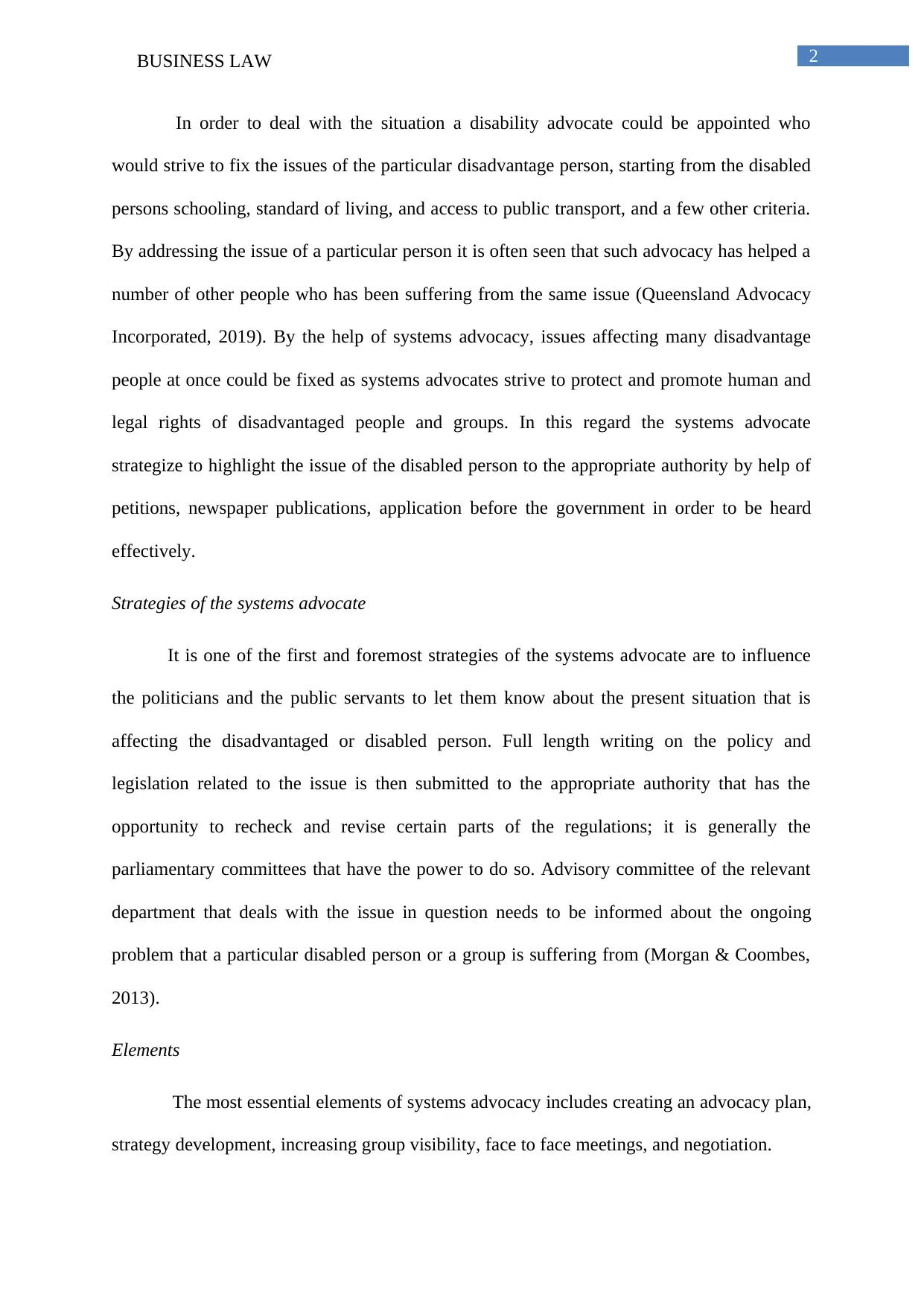
2BUSINESS LAW
In order to deal with the situation a disability advocate could be appointed who
would strive to fix the issues of the particular disadvantage person, starting from the disabled
persons schooling, standard of living, and access to public transport, and a few other criteria.
By addressing the issue of a particular person it is often seen that such advocacy has helped a
number of other people who has been suffering from the same issue (Queensland Advocacy
Incorporated, 2019). By the help of systems advocacy, issues affecting many disadvantage
people at once could be fixed as systems advocates strive to protect and promote human and
legal rights of disadvantaged people and groups. In this regard the systems advocate
strategize to highlight the issue of the disabled person to the appropriate authority by help of
petitions, newspaper publications, application before the government in order to be heard
effectively.
Strategies of the systems advocate
It is one of the first and foremost strategies of the systems advocate are to influence
the politicians and the public servants to let them know about the present situation that is
affecting the disadvantaged or disabled person. Full length writing on the policy and
legislation related to the issue is then submitted to the appropriate authority that has the
opportunity to recheck and revise certain parts of the regulations; it is generally the
parliamentary committees that have the power to do so. Advisory committee of the relevant
department that deals with the issue in question needs to be informed about the ongoing
problem that a particular disabled person or a group is suffering from (Morgan & Coombes,
2013).
Elements
The most essential elements of systems advocacy includes creating an advocacy plan,
strategy development, increasing group visibility, face to face meetings, and negotiation.
In order to deal with the situation a disability advocate could be appointed who
would strive to fix the issues of the particular disadvantage person, starting from the disabled
persons schooling, standard of living, and access to public transport, and a few other criteria.
By addressing the issue of a particular person it is often seen that such advocacy has helped a
number of other people who has been suffering from the same issue (Queensland Advocacy
Incorporated, 2019). By the help of systems advocacy, issues affecting many disadvantage
people at once could be fixed as systems advocates strive to protect and promote human and
legal rights of disadvantaged people and groups. In this regard the systems advocate
strategize to highlight the issue of the disabled person to the appropriate authority by help of
petitions, newspaper publications, application before the government in order to be heard
effectively.
Strategies of the systems advocate
It is one of the first and foremost strategies of the systems advocate are to influence
the politicians and the public servants to let them know about the present situation that is
affecting the disadvantaged or disabled person. Full length writing on the policy and
legislation related to the issue is then submitted to the appropriate authority that has the
opportunity to recheck and revise certain parts of the regulations; it is generally the
parliamentary committees that have the power to do so. Advisory committee of the relevant
department that deals with the issue in question needs to be informed about the ongoing
problem that a particular disabled person or a group is suffering from (Morgan & Coombes,
2013).
Elements
The most essential elements of systems advocacy includes creating an advocacy plan,
strategy development, increasing group visibility, face to face meetings, and negotiation.
⊘ This is a preview!⊘
Do you want full access?
Subscribe today to unlock all pages.

Trusted by 1+ million students worldwide
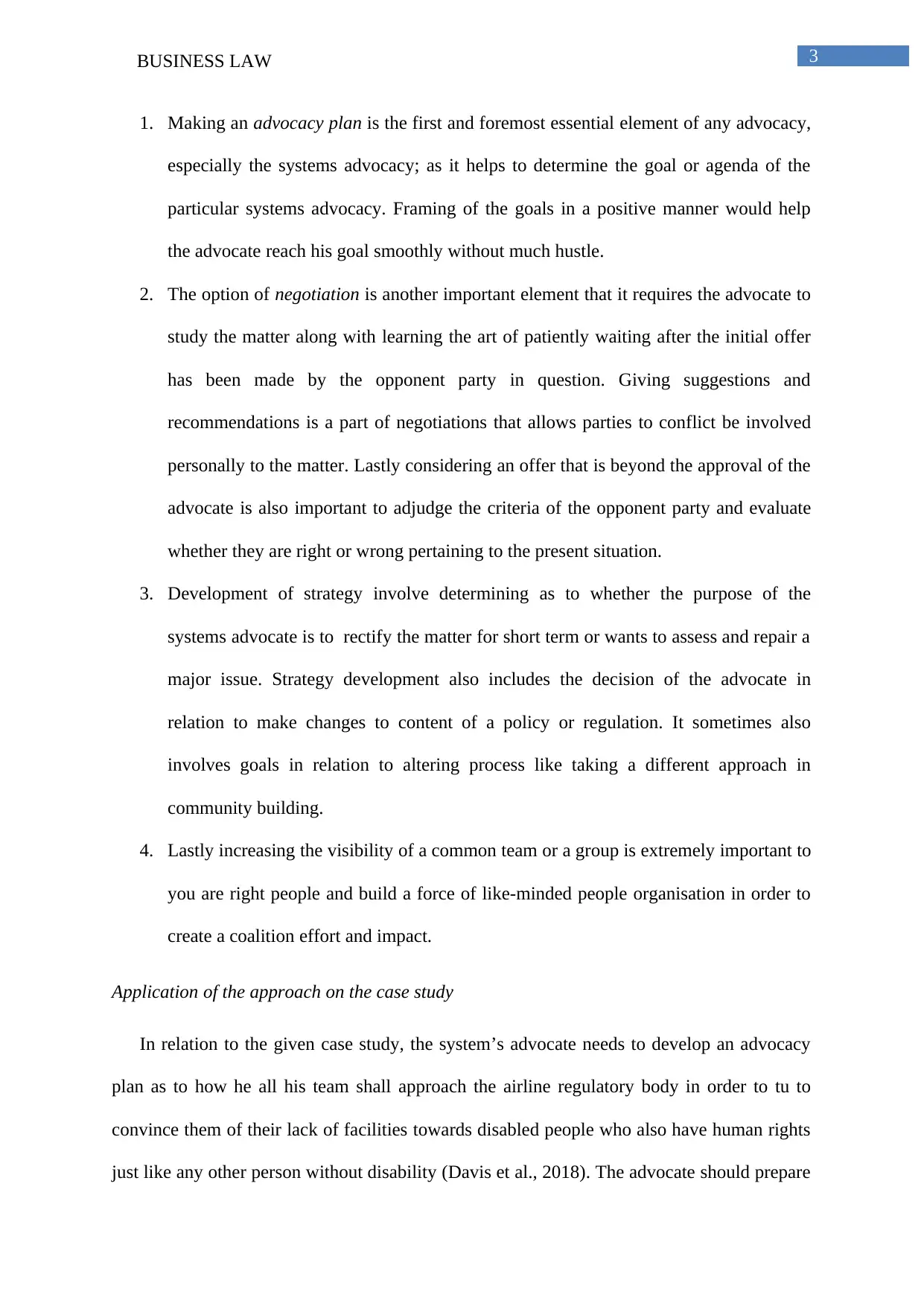
3BUSINESS LAW
1. Making an advocacy plan is the first and foremost essential element of any advocacy,
especially the systems advocacy; as it helps to determine the goal or agenda of the
particular systems advocacy. Framing of the goals in a positive manner would help
the advocate reach his goal smoothly without much hustle.
2. The option of negotiation is another important element that it requires the advocate to
study the matter along with learning the art of patiently waiting after the initial offer
has been made by the opponent party in question. Giving suggestions and
recommendations is a part of negotiations that allows parties to conflict be involved
personally to the matter. Lastly considering an offer that is beyond the approval of the
advocate is also important to adjudge the criteria of the opponent party and evaluate
whether they are right or wrong pertaining to the present situation.
3. Development of strategy involve determining as to whether the purpose of the
systems advocate is to rectify the matter for short term or wants to assess and repair a
major issue. Strategy development also includes the decision of the advocate in
relation to make changes to content of a policy or regulation. It sometimes also
involves goals in relation to altering process like taking a different approach in
community building.
4. Lastly increasing the visibility of a common team or a group is extremely important to
you are right people and build a force of like-minded people organisation in order to
create a coalition effort and impact.
Application of the approach on the case study
In relation to the given case study, the system’s advocate needs to develop an advocacy
plan as to how he all his team shall approach the airline regulatory body in order to tu to
convince them of their lack of facilities towards disabled people who also have human rights
just like any other person without disability (Davis et al., 2018). The advocate should prepare
1. Making an advocacy plan is the first and foremost essential element of any advocacy,
especially the systems advocacy; as it helps to determine the goal or agenda of the
particular systems advocacy. Framing of the goals in a positive manner would help
the advocate reach his goal smoothly without much hustle.
2. The option of negotiation is another important element that it requires the advocate to
study the matter along with learning the art of patiently waiting after the initial offer
has been made by the opponent party in question. Giving suggestions and
recommendations is a part of negotiations that allows parties to conflict be involved
personally to the matter. Lastly considering an offer that is beyond the approval of the
advocate is also important to adjudge the criteria of the opponent party and evaluate
whether they are right or wrong pertaining to the present situation.
3. Development of strategy involve determining as to whether the purpose of the
systems advocate is to rectify the matter for short term or wants to assess and repair a
major issue. Strategy development also includes the decision of the advocate in
relation to make changes to content of a policy or regulation. It sometimes also
involves goals in relation to altering process like taking a different approach in
community building.
4. Lastly increasing the visibility of a common team or a group is extremely important to
you are right people and build a force of like-minded people organisation in order to
create a coalition effort and impact.
Application of the approach on the case study
In relation to the given case study, the system’s advocate needs to develop an advocacy
plan as to how he all his team shall approach the airline regulatory body in order to tu to
convince them of their lack of facilities towards disabled people who also have human rights
just like any other person without disability (Davis et al., 2018). The advocate should prepare
Paraphrase This Document
Need a fresh take? Get an instant paraphrase of this document with our AI Paraphraser
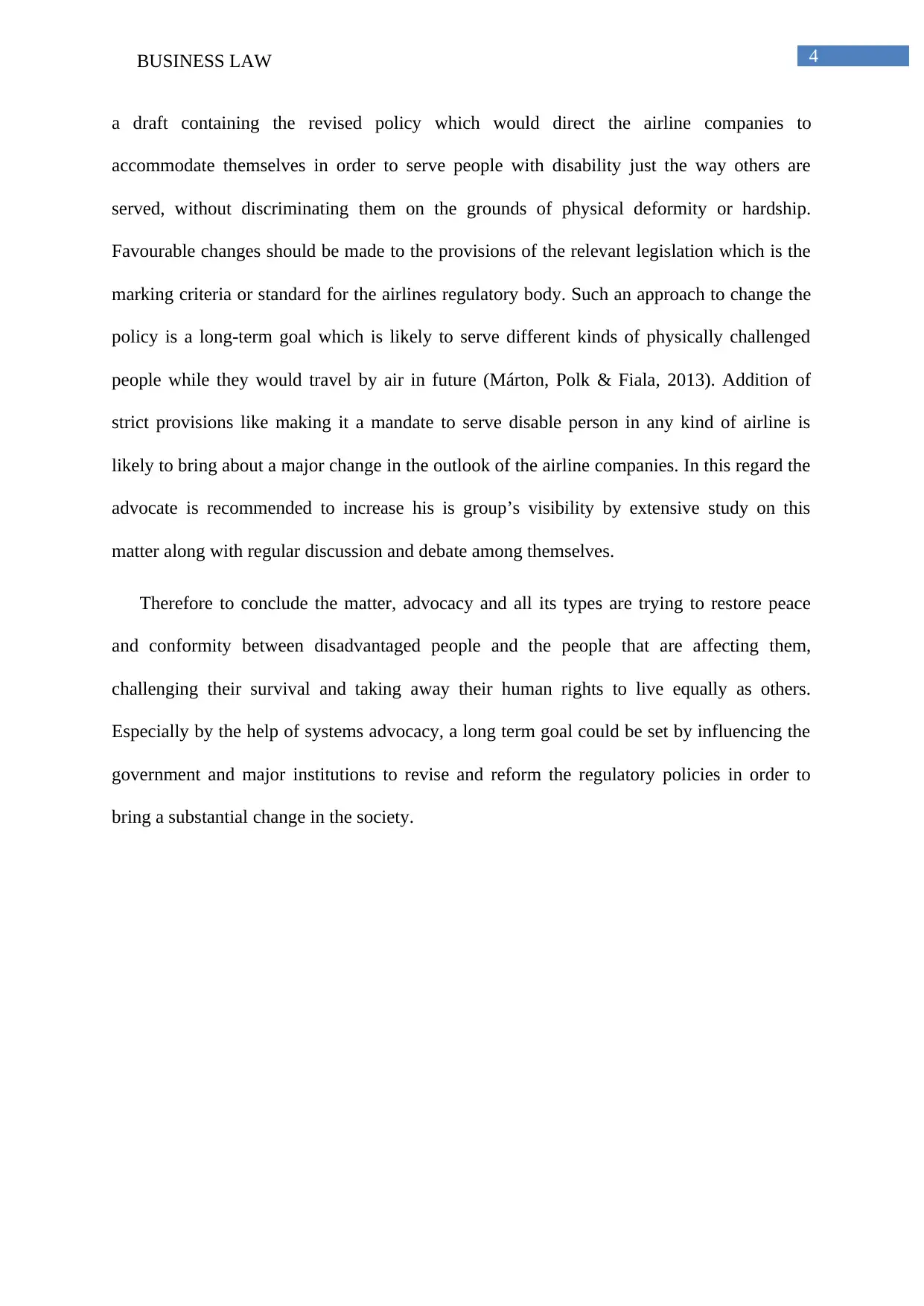
4BUSINESS LAW
a draft containing the revised policy which would direct the airline companies to
accommodate themselves in order to serve people with disability just the way others are
served, without discriminating them on the grounds of physical deformity or hardship.
Favourable changes should be made to the provisions of the relevant legislation which is the
marking criteria or standard for the airlines regulatory body. Such an approach to change the
policy is a long-term goal which is likely to serve different kinds of physically challenged
people while they would travel by air in future (Márton, Polk & Fiala, 2013). Addition of
strict provisions like making it a mandate to serve disable person in any kind of airline is
likely to bring about a major change in the outlook of the airline companies. In this regard the
advocate is recommended to increase his is group’s visibility by extensive study on this
matter along with regular discussion and debate among themselves.
Therefore to conclude the matter, advocacy and all its types are trying to restore peace
and conformity between disadvantaged people and the people that are affecting them,
challenging their survival and taking away their human rights to live equally as others.
Especially by the help of systems advocacy, a long term goal could be set by influencing the
government and major institutions to revise and reform the regulatory policies in order to
bring a substantial change in the society.
a draft containing the revised policy which would direct the airline companies to
accommodate themselves in order to serve people with disability just the way others are
served, without discriminating them on the grounds of physical deformity or hardship.
Favourable changes should be made to the provisions of the relevant legislation which is the
marking criteria or standard for the airlines regulatory body. Such an approach to change the
policy is a long-term goal which is likely to serve different kinds of physically challenged
people while they would travel by air in future (Márton, Polk & Fiala, 2013). Addition of
strict provisions like making it a mandate to serve disable person in any kind of airline is
likely to bring about a major change in the outlook of the airline companies. In this regard the
advocate is recommended to increase his is group’s visibility by extensive study on this
matter along with regular discussion and debate among themselves.
Therefore to conclude the matter, advocacy and all its types are trying to restore peace
and conformity between disadvantaged people and the people that are affecting them,
challenging their survival and taking away their human rights to live equally as others.
Especially by the help of systems advocacy, a long term goal could be set by influencing the
government and major institutions to revise and reform the regulatory policies in order to
bring a substantial change in the society.
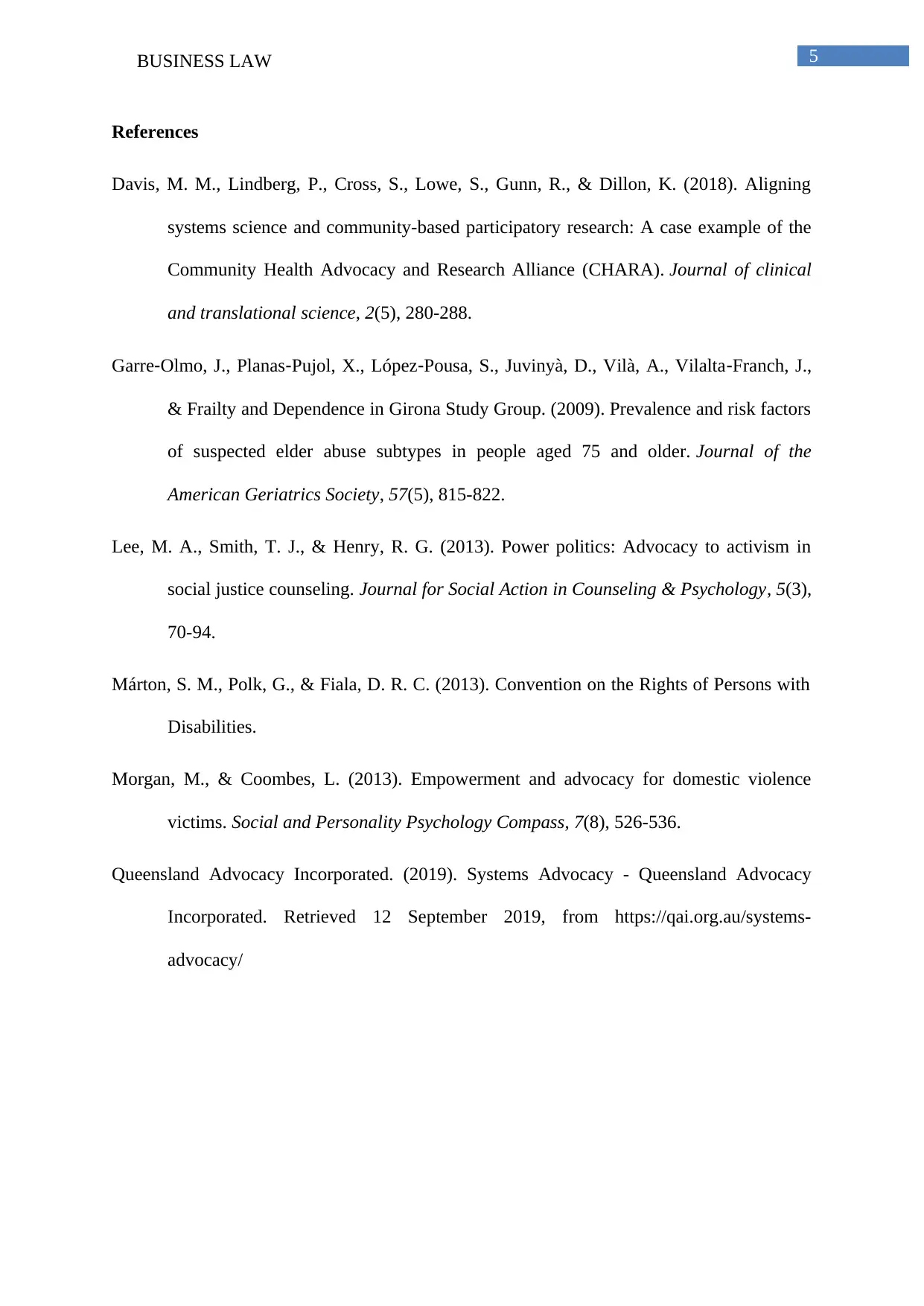
5BUSINESS LAW
References
Davis, M. M., Lindberg, P., Cross, S., Lowe, S., Gunn, R., & Dillon, K. (2018). Aligning
systems science and community-based participatory research: A case example of the
Community Health Advocacy and Research Alliance (CHARA). Journal of clinical
and translational science, 2(5), 280-288.
Garre‐Olmo, J., Planas‐Pujol, X., López‐Pousa, S., Juvinyà, D., Vilà, A., Vilalta‐Franch, J.,
& Frailty and Dependence in Girona Study Group. (2009). Prevalence and risk factors
of suspected elder abuse subtypes in people aged 75 and older. Journal of the
American Geriatrics Society, 57(5), 815-822.
Lee, M. A., Smith, T. J., & Henry, R. G. (2013). Power politics: Advocacy to activism in
social justice counseling. Journal for Social Action in Counseling & Psychology, 5(3),
70-94.
Márton, S. M., Polk, G., & Fiala, D. R. C. (2013). Convention on the Rights of Persons with
Disabilities.
Morgan, M., & Coombes, L. (2013). Empowerment and advocacy for domestic violence
victims. Social and Personality Psychology Compass, 7(8), 526-536.
Queensland Advocacy Incorporated. (2019). Systems Advocacy - Queensland Advocacy
Incorporated. Retrieved 12 September 2019, from https://qai.org.au/systems-
advocacy/
References
Davis, M. M., Lindberg, P., Cross, S., Lowe, S., Gunn, R., & Dillon, K. (2018). Aligning
systems science and community-based participatory research: A case example of the
Community Health Advocacy and Research Alliance (CHARA). Journal of clinical
and translational science, 2(5), 280-288.
Garre‐Olmo, J., Planas‐Pujol, X., López‐Pousa, S., Juvinyà, D., Vilà, A., Vilalta‐Franch, J.,
& Frailty and Dependence in Girona Study Group. (2009). Prevalence and risk factors
of suspected elder abuse subtypes in people aged 75 and older. Journal of the
American Geriatrics Society, 57(5), 815-822.
Lee, M. A., Smith, T. J., & Henry, R. G. (2013). Power politics: Advocacy to activism in
social justice counseling. Journal for Social Action in Counseling & Psychology, 5(3),
70-94.
Márton, S. M., Polk, G., & Fiala, D. R. C. (2013). Convention on the Rights of Persons with
Disabilities.
Morgan, M., & Coombes, L. (2013). Empowerment and advocacy for domestic violence
victims. Social and Personality Psychology Compass, 7(8), 526-536.
Queensland Advocacy Incorporated. (2019). Systems Advocacy - Queensland Advocacy
Incorporated. Retrieved 12 September 2019, from https://qai.org.au/systems-
advocacy/
⊘ This is a preview!⊘
Do you want full access?
Subscribe today to unlock all pages.

Trusted by 1+ million students worldwide
1 out of 6
Related Documents
Your All-in-One AI-Powered Toolkit for Academic Success.
+13062052269
info@desklib.com
Available 24*7 on WhatsApp / Email
![[object Object]](/_next/static/media/star-bottom.7253800d.svg)
Unlock your academic potential
Copyright © 2020–2025 A2Z Services. All Rights Reserved. Developed and managed by ZUCOL.




